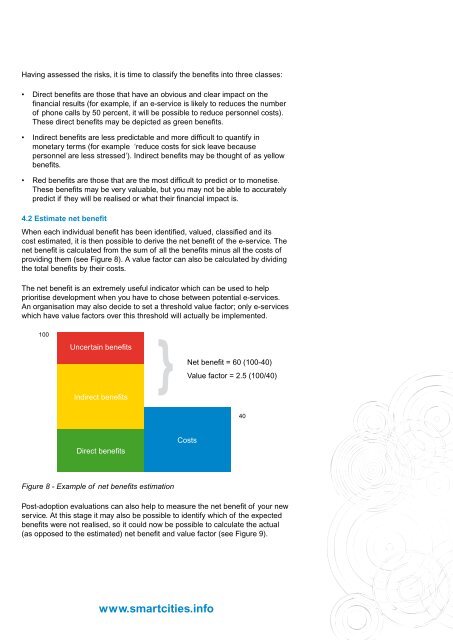Evaluating the impact of local e-services - Smart Cities
Evaluating the impact of local e-services - Smart Cities
Evaluating the impact of local e-services - Smart Cities
Create successful ePaper yourself
Turn your PDF publications into a flip-book with our unique Google optimized e-Paper software.
Having assessed <strong>the</strong> risks, it is time to classify <strong>the</strong> benefits into three classes:<br />
• Direct benefits are those that have an obvious and clear <strong>impact</strong> on <strong>the</strong><br />
financial results (for example, if an e-service is likely to reduces <strong>the</strong> number<br />
<strong>of</strong> phone calls by 50 percent, it will be possible to reduce personnel costs).<br />
These direct benefits may be depicted as green benefits.<br />
• Indirect benefits are less predictable and more difficult to quantify in<br />
monetary terms (for example ‘reduce costs for sick leave because<br />
personnel are less stressed’). Indirect benefits may be thought <strong>of</strong> as yellow<br />
benefits.<br />
• Red benefits are those that are <strong>the</strong> most difficult to predict or to monetise.<br />
These benefits may be very valuable, but you may not be able to accurately<br />
predict if <strong>the</strong>y will be realised or what <strong>the</strong>ir financial <strong>impact</strong> is.<br />
4.2 Estimate net benefit<br />
When each individual benefit has been identified, valued, classified and its<br />
cost estimated, it is <strong>the</strong>n possible to derive <strong>the</strong> net benefit <strong>of</strong> <strong>the</strong> e-service. The<br />
net benefit is calculated from <strong>the</strong> sum <strong>of</strong> all <strong>the</strong> benefits minus all <strong>the</strong> costs <strong>of</strong><br />
providing <strong>the</strong>m (see Figure 8). A value factor can also be calculated by dividing<br />
<strong>the</strong> total benefits by <strong>the</strong>ir costs.<br />
The net benefit is an extremely useful indicator which can be used to help<br />
prioritise development when you have to chose between potential e-<strong>services</strong>.<br />
An organisation may also decide to set a threshold value factor; only e-<strong>services</strong><br />
which have value factors over this threshold will actually be implemented.<br />
100<br />
Uncertain benefits<br />
Indirect benefits<br />
Direct benefits<br />
Figure 8 - Example <strong>of</strong> net benefits estimation<br />
Costs<br />
Post-adoption evaluations can also help to measure <strong>the</strong> net benefit <strong>of</strong> your new<br />
service. At this stage it may also be possible to identify which <strong>of</strong> <strong>the</strong> expected<br />
benefits were not realised, so it could now be possible to calculate <strong>the</strong> actual<br />
(as opposed to <strong>the</strong> estimated) net benefit and value factor (see Figure 9).<br />
www.smartcities.info<br />
Net benefit = 60 (100-40)<br />
Value factor = 2.5 (100/40)<br />
40



